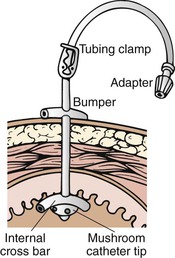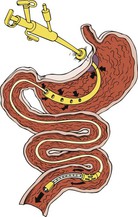Skill 24
Enteral Nutrition via a Gastrostomy or Jejunostomy Tube
Feeding tubes can be placed directly into the gastrointestinal (GI) tract through the abdominal wall in patients who cannot tolerate nasoenteric feeding tubes or require long-term enteral nutrition. The stomach (gastrostomy tube) and jejunum (jejunostomy tube) are the most common sites for long-term feeding tubes. Feedings delivered via a gastrostomy tube are relatively safe to administer, provided the patient has normal gastric emptying. Gastrostomy tubes are often called G tubes but are also referred to as percutaneous endoscopic gastrostomy (PEG) tubes. Gastrostomy tubes range in size from 16 Fr to 28 Fr and exit through an incision in the upper left quadrant of the abdomen, where an internal bumper or balloon and an external bumper or disk hold the tube in place (Fig. 24-1).
Jejunostomy tubes are indicated when the risk of regurgitation and aspiration is especially high. Jejunostomy tubes can be placed into the small intestine in a surgical procedure or threaded through the stomach into the jejunum under fluoroscopy. The percutaneous endoscopic jejunostomy (PEJ) tube is passed through the PEG and advanced into the jejunum (Fig. 24-2).
Delegation Considerations
The skill of administration of nasoenteral tube feeding can be delegated to nursing assistive personnel (NAP). However, a registered nurse (RN) or licensed practical nurse (LPN) must first verify tube placement and patency. The nurse directs the NAP to:
▪ Not adjust feeding rate; infuse the feeding as ordered.
▪ Report any difficulty infusing the feeding or any discomfort voiced by the patient.
Stay updated, free articles. Join our Telegram channel

Full access? Get Clinical Tree




